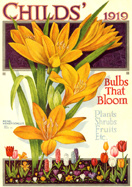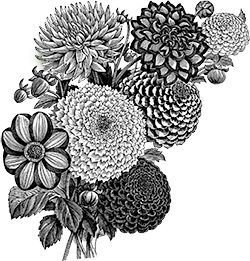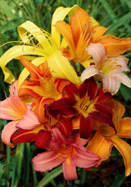Order these spring-planted bulbs NOW for shipping in the next week.
All bulbs for spring 2025 are SOLD OUT.
Order for spring 2026 starting August!
when spring bulbs are back for sale.
|
ARE DAYLILIES BULBS? Not really, but bulb catalogs in the past offered their thick, fleshy roots, and today many antique daylilies are at risk, so we’ve added them to our Ark. Modern daylilies can be amazing, but older ones blend better into most gardens. They’re not huge or gaudy, and their classic, lily-like forms are full of grace.
TIPS FOR SUCCESS: Daylilies are one of the easiest of all perennials. See what you’ll get: freshly dug, bare-root plants with 2-4 fans (growing points). Plant in full sun to light shade, and learn more here.
|
|
|
|
|
With cottage-garden grace and surprising diversity, antique daylilies are waiting to be rediscovered by modern gardeners. Sample their old-fashioned charms with 3 of our favorites, all different, labeled, and great for your area. (Several possibilities are pictured.) For zones 4a-8b(9aWC).
For more of each variety, order additional samplers.
Daylily care.
If you’d like to be notified when it’s back in stock, click to sign up for an email alert.
Spring shipped, click here for summer shipped.
|
|
|
|
Red-headed ‘Annette’ is a spunky little World War II daylily with curling, ribbon-like petals and a wide-open heart of pure sunshine. At just 20 inches tall, it’s perfect for small gardens or the front of a perennial border. It’s one of the most enduring legacies of Texan H.M. Russell who at one point was growing more daylilies than anyone else in America. Early-mid summer, zones 4a-8b(10bWC), from Missouri.
Chart and care.
If you’d like to be notified when it’s back in stock, click to sign up for an email alert.
|
|
|
|
Last offered in 2015. Here’s the beginning of daylilies as we know them today. Introduced in 1893 by schoolteacher George Yeld, ‘Apricot’ was the first hybrid daylily and its success opened the door for the 60,000 others that have followed. Spring-blooming (starting in early May here in zone 6a) and often reblooming in the fall, it has vivid little flowers of orange-yellow peeking above a fountain of leaves — making it well worth growing even if it weren’t so historic. 28-34”, early, deciduous, zones 4a-8b(10aWC), from Ann Arbor. Apricot is also available for summer delivery. Chart and care. Spring shipped, click here for summer shipped.
|
|
|
|
Our longest blooming daylily, ‘August Pioneer’ opens its bright, graceful trumpets for up to eight weeks. Its color is something special, too, a softly glowing orange with hints of apricot that blends in harmoniously yet will draw you across the garden. And it multiplies quickly. All in all, it’s a masterpiece from A.B. Stout, the patriarch of daylilies. 34”, mid-late, deciduous, 3-4 fans, zones 4a-8b(9bWC), from Missouri & our own micro-farm. August Pioneer is also available for summer delivery. Chart and care.
|
|
|
|
Tall, tall, TALL – with bloom stalks up to 7 feet! – this remarkable daylily may get you and your garden visitors babbling. Up close its spidery, gold and chestnut flowers are nothing special, but when you see them held high against the sky on their strong, slender stalks – often with hummingbirds flitting about – they’re magic. By A.B. Stout, from the wild H. altissima, 5-7’, late blooming, lightly fragrant, deciduous, 2-3 fans, zones 4a-8b(10aWC), from our own micro-farm. Autumn Minaret is also available for summer delivery. Chart, care, and learn more. Spring shipped, click here for summer shipped.
|
|
|
|
With its velvety, wine-dark petals, chartreuse throat, and graceful, lily-like form, ‘Black Friar’ is one of the best of the mid-century “black” daylilies. Tall and vigorous, it was bred by the first woman to win the AHS’s top award for hybridizing, “Sun-Proof” Mary Lester of Georgia. 32-38”, mid-to-late, deciduous, 2 fans, zones 4a-8b(10aWC), from our own micro-farm. Black Friar is also available for summer delivery. Chart and care. Spring shipped, click here for summer shipped.
|
|
|
|
‘Caballero’s long, curling petals are gold and an intriguing rusty brown (yes, brown!) that may remind you of saddle-leather and sandstone buttes – which is probably just what Stout had in mind when he named it. Caballeros were the noble “gentlemen-cowboys” of popular movies such as The Bold Caballero of 1936 with its dashing hero, Zorro. 36-40”, early-mid season, evergreen, 2 large fans, zones 4a-9b(10bWC), from our own micro-farm. Caballero is also available for summer delivery. Chart and care. Spring shipped, click here for summer shipped.
|
|
|
|
This dramatically tall, colorful daylily will draw your eye from the farthest reaches of your garden. It gets its height – five feet or more here – from H. altissima, native to the mountains of Nanjing, and with 25-30 buds per stem, its striking red flowers will entertain you from mid-summer into fall. By A.B. Stout, 48-72”, deciduous, 2-3 fans, zones 4a-8b(10bWC), from Michigan. Challenger is also available for summer delivery. Chart, care, and learn more. Spring shipped, click here for summer shipped.
|
|
|
|
Last offered in 2020. This great little daylily has a lot of famous friends. Ken Druse first urged us to offer it, Christopher Lloyd called it a “first-rate AGM winner,” and Pamela Harper in Time-Tested Plants writes, “I doubt that any daylily will ever please me more than ‘Corky’.” Its small, wildflowery blooms are shaded with bronze on the outside, and since every wiry stem holds up to 40 buds, they open for a long time. 34”, mid-season, deciduous, zones 5a-8b(10bWC), grown by us here in Ann Arbor.
Chart, care, and learn more.
If you’d like to be notified when it’s back in stock, click to sign up for an email alert.
|
|
|
|
With up to 30 buds per stem, this Nebraska-bred classic will brighten your mid-summer garden with six weeks of star-like, jewel-toned blossoms that are as graceful as wildflowers. Named for a hit movie that later inspired Pirates of the Caribbean, it’s another masterpiece from the great Henry Sass whose family introduced so many enduringly popular iris and peonies. 30-32”, mid-season, deciduous, zones 4a-8b(10aWC), from Missouri.
Chart and care.
If you’d like to be notified when it’s back in stock, click to sign up for an email alert.
|
|
|
|
“Did you see that?” everyone asked when this unusual daylily first bloomed here in our trial garden. With its long, thin, curling petals, a clump in bloom may remind you of fireworks bursting in the summer sky. A landmark daylily, it was the first “spider,” a form that’s now in vogue after decades of scorn. 24-36”, mid-summer blooming, deciduous, zones 4a-8b(10bWC), from our own micro-farm. Kindly Light is also available for summer delivery. Chart and care. Spring shipped, click here for summer shipped.
|
|
|
|
The “rich, lustrous, velvety black cherry color” of this old daylily (in the words of the 1949 Schreiner’s catalog) would be great no matter what, but it’s the creamy white line down the center of each petal that makes it so striking and unforgettable. You’ll find yourself drawn to it from across the garden – and looking forward to it every summer. 34-36”, mid-season, dormant, 2 fans, zones 4a-8a(10aWC), from our own micro-farm. Libby Finch is also available for summer delivery. Chart and care. Spring shipped, click here for summer shipped.
|
|
|
|
One of the oldest daylilies of all, and very hard to find today. This lightly fragrant beauty came from a clump growing in OHG founder Scott’s front yard – until we dug it up to share with you. (No problem!) It was bred by R. Wallace and Co., importers of some of the first daylilies from China, and praised in the June 1900 Country Life as “a Day Lily of great beauty, vigorous and handsome.” 28-32”, early-mid, deciduous, 2 fans, zones 5a-8a(10aWC), from our own micro-farm. Luteola is also available for summer delivery. Chart and care. Spring shipped, click here for summer shipped.
|
|
|
|
When we asked the experts, this pastel gem topped the list of heirloom daylilies we just had to offer. Its pale, melon-pink color was an exciting advance for the 1950s, and – enhanced by a cool green throat – it’s still exciting and lovely today. Winner of the Stout Medal, it was bred by Edna Spalding of rural Louisiana who grew her seedlings in the vegetable garden and culled the rejects with a kitchen knife. 32”, mid-summer blooming, deciduous, zones 4a-8b(10bWC), from Michigan. Luxury Lace is also available for summer delivery. Chart and care. Spring shipped, click here for summer shipped.
|
|
|
|
This striking daylily was one of Stout’s first and favorite introductions. Over the years its bold mango-and-mahogany coloring and graceful star-like form have won it many fans, including the great Elizabeth Lawrence who praised it as one of her “15 Best.” Vigorously multiplying and floriferous, it often reblooms in the fall in warm areas. 30-36”, early-mid season, semi-evergreen, 2 fans, zones 4a-8b(10aWC), from our own micro-farm. Mikado is also available for summer delivery. Chart and care. Spring shipped, click here for summer shipped.
|
|
|
|
Much more than just another yellow daylily, ‘Ophir’ has unusually long, trumpet-shaped flowers – almost like an Easter lily – making it one of the most graceful and distinctive daylilies we’ve ever seen. It’s also one of the first American-bred daylilies, by Bertrand Farr, and the great Elizabeth Lawrence grew it, writing in 1943 that it was “more beautiful than ever this season, and the only attention it has ever had is a mulch of cow manure each fall.” 38-46”, mid-season, semi-evergreen, 2-3 fans, zones 4a-8b(10aWC), from our own micro-farm.
Chart, care, and learn more.
If you’d like to be notified when it’s back in stock, click to sign up for an email alert.
|
|
|
|
One of the latest, longest-blooming, and brightest daylilies we grow, ‘Princess Irene’ will draw you from across the garden with its joyful brilliance, from mid-summer well into fall. With its star-like form and almost wriggling petals, it’s the only daylily ever introduced by H. A. Zager of Des Moines – but he sure picked a winner. 28-34”, late-mid to late, deciduous, 2 fans, zones 4a-8a(10aWC), from our Ann Arbor micro-farm. Prinses Irene is also available for summer delivery. Chart and care. Spring shipped, click here for summer shipped.
|
|
|
|
Named after the 1964 movie of the same name, or perhaps after the nursery rhyme that inspired it, ‘Pumpkin Eater’ has sturdy stems supporting a feast of 5” blossoms in pastel shades of melon and apricot: We've counted as many as 39 flower buds on one stem! 30”, mid-late, zones 4a-8b(10bWC), from our own micro-farm.
Chart and care.
If you’d like to be notified when it’s back in stock, click to sign up for an email alert.
|
|
|
|
60 years ago this tall, dark-red/burgundy daylily caused ripples with its long elegant petals and vigorous growth. It contrasts beautifully with yellow and gold neighbors and can rebloom throughout the summer. 36”, early-mid, 2-3 fans, zones 4a-8b(10bWC), from our own micro-farm. Purple Waters is also available for summer delivery. Chart and care. Spring shipped, click here for summer shipped.
|
|
|
|
Last offered in 2011. What sets this mighty classic apart — and why should you give it a try? It’s more fragrant than its famous parent ‘Hyperion’. Its Chicago breeding makes it extra tough. And its lily-like, moonlight-yellow flowers stay open longer than most, making it especially beautiful in the evening garden — when you’ll be home to enjoy it. 36” mid-summer blooming, deciduous, zones 4a-8b(9aWC), from Missouri.
Chart and care.
If you’d like to be notified when it’s back in stock, click to sign up for an email alert.
|
|
|
|
True stock! Many daylilies are mistakenly called lemon lily, but ours is the true original. For centuries, this and the single orange “ditch lily” were the only daylilies common in gardens. Always the more prized, lemon lily is smaller, much more graceful, and early blooming, with a sweet scent that led one botanist in 1733 to call it the “Yellow Tuberose.” Best in cool climates and moist soils. We ship single fans of this great rarity. Formerly H. flava, 24-32”, deciduous, zones 3a-7a(9aWC), from our own micro-farm.
|
|
DAYLILY ARCHIVES — For customer tips and raves, history, news, and more, see our Daylillies Newsletter Archives.
PLANTING & CARE — Plant these bare-root perennials as soon as possible in the spring. They’re eager to grow, can take light frost, and need water and sunlight to stay healthy. If necessary, store in a plastic bag in the refrigerator for a few days or “heel in” briefly in moist sand or soil in a shady spot.
Daylilies like lots of sun but most bloom well in light shade, too, and often prefer it in the South. Loamy, well-drained soil suits them best, but they’re adaptable and should do fine in any soil that’s not too wet or dry.
Plant 18-24 inches apart (to leave growing room for future years) with the crown (where the foliage meets the roots) no more than one inch below the soil surface. Dig a hole big enough to fit the roots comfortably, mound soil in the center, set the plant on top, and spread the roots out down the sides of the mound. Fill in and firm soil around roots, making sure the crown ends up no more than one inch deep. Water well.
Water regularly, especially the first year and from spring till flowering in future years. First-year plants usually bloom sparsely — if at all — concentrating instead on developing a strong root system. Deadhead (remove) spent blooms daily for a neater look and, to increase bloom the following year, remove any seedpods that may form.
After bloom, normal senescence (aging) may cause foliage to subside, yellow, or turn brown at the tips. If this bothers you, feel free to trim it a bit or even cut the foliage to the ground completely — though not the first year! With good care, fresh new foliage will emerge.
Daylilies are hardy perennials and winter protection is rarely needed. In spring, remove dead foliage, fertilize if indicated by a soil test, and resume watering.
For more information, including tips on the few pests and diseases that occasionally trouble daylilies, see the “Frequently Asked Questions” section of the excellent American Hemerocallis Society website.
|


































